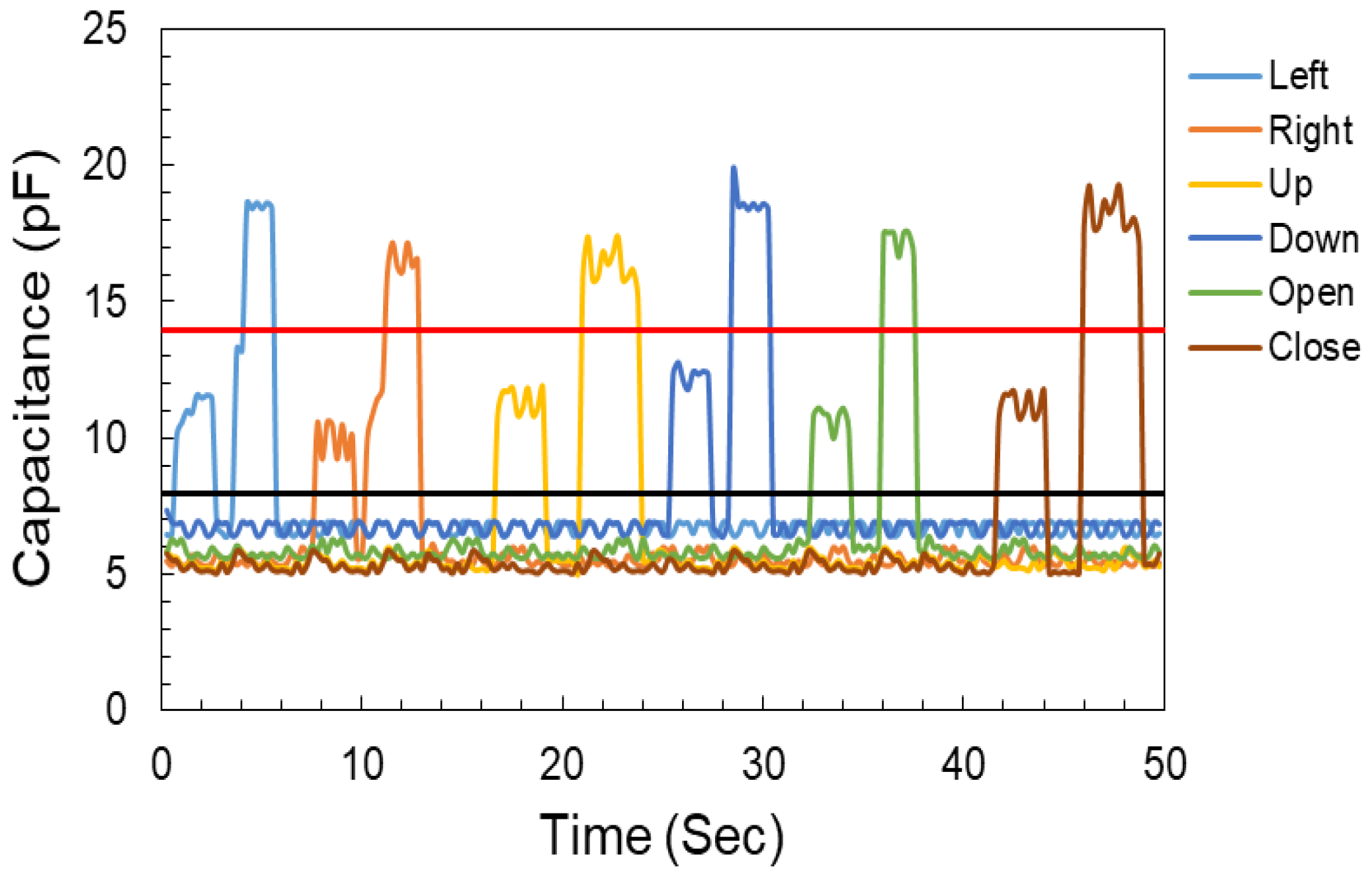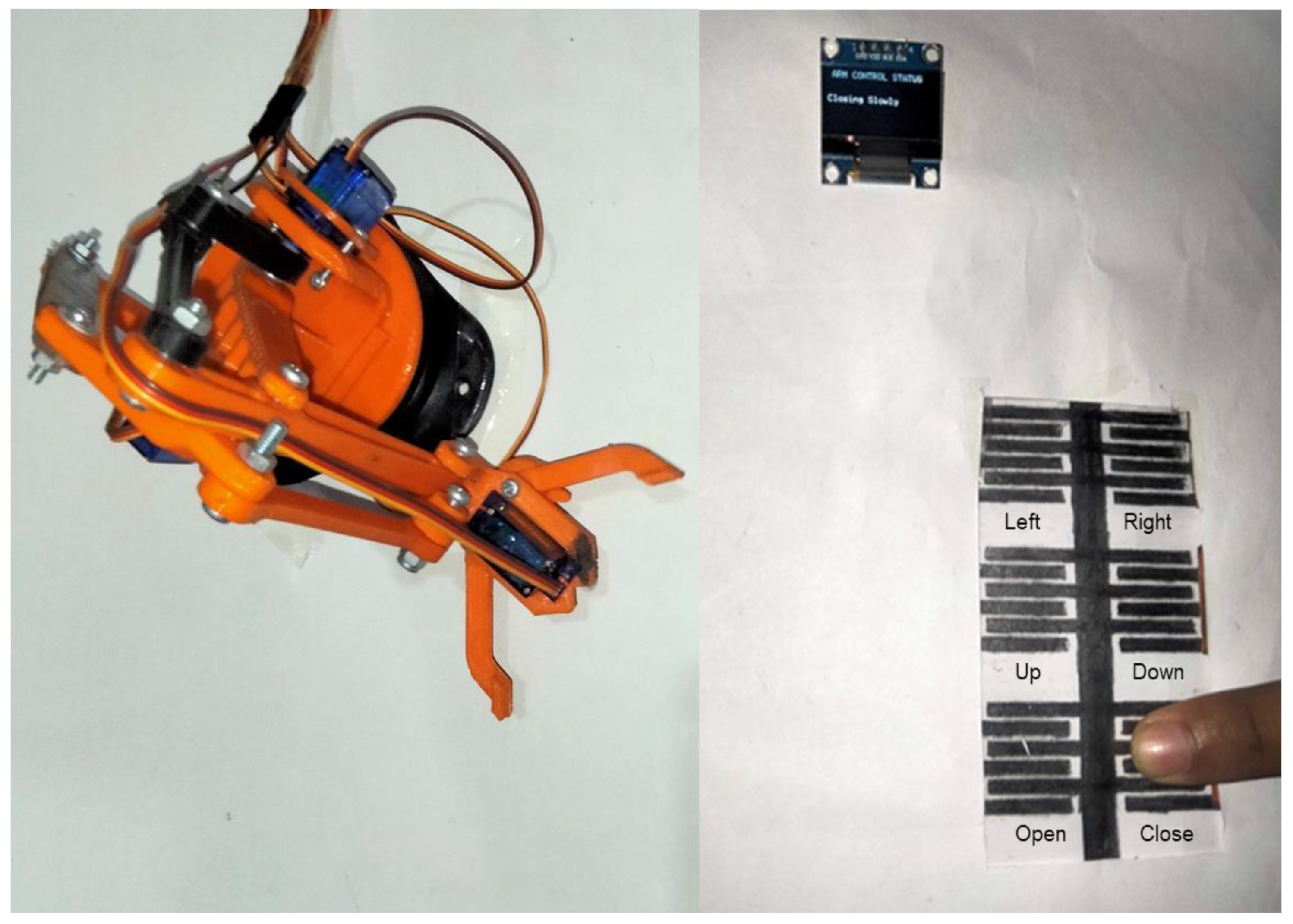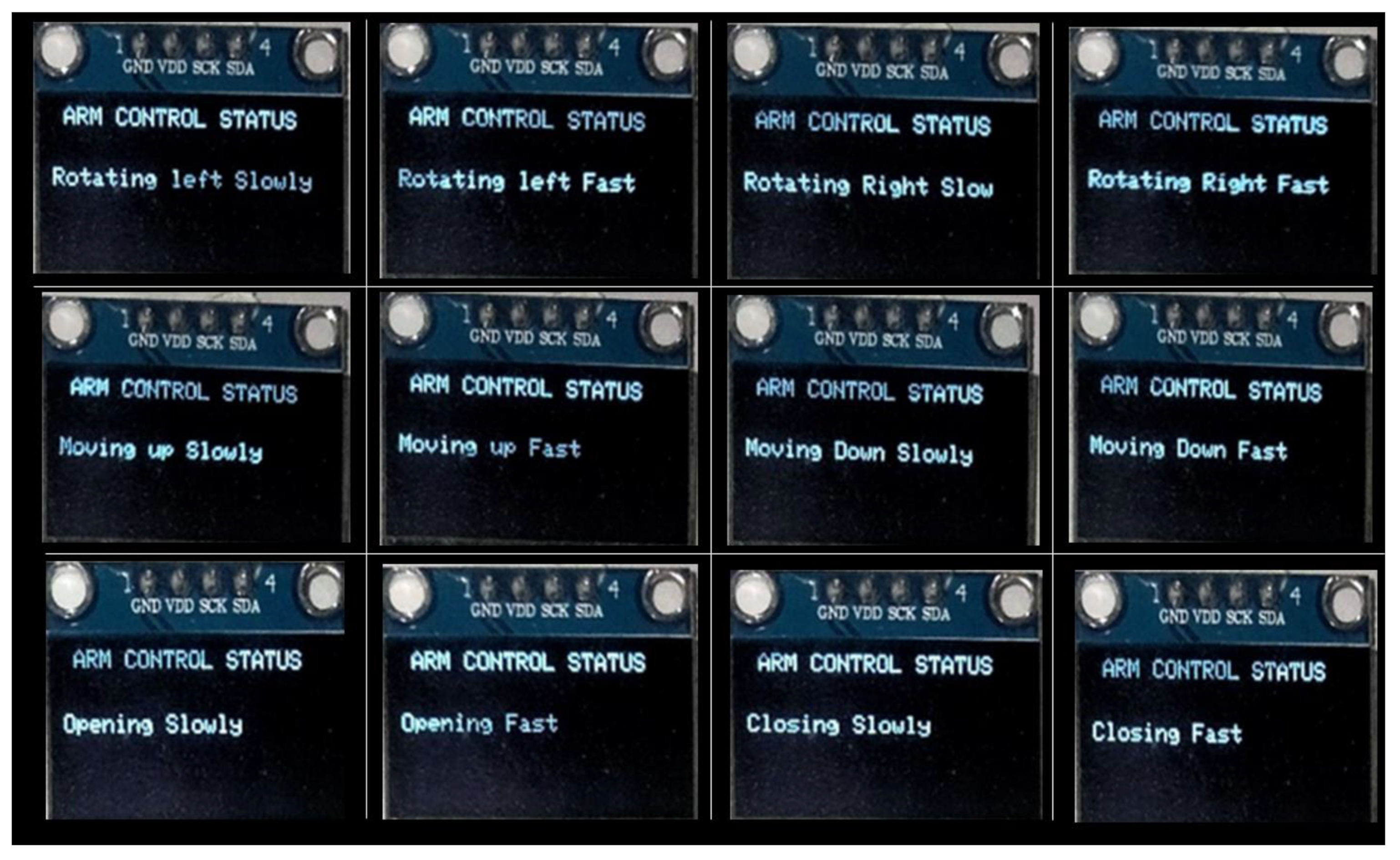Facile Pressure-Sensitive Capacitive Touch Keypad for a Green Intelligent Human–Machine Interface
Abstract
:1. Introduction
2. Materials and Methods
2.1. Materials
2.2. Design and Fabrication
3. Experimental Section
4. Results and Discussion
5. Conclusions
Author Contributions
Funding
Institutional Review Board Statement
Informed Consent Statement
Data Availability Statement
Conflicts of Interest
References
- Mazzeo, A.D.; Kalb, W.B.; Chan, L.; Killian, M.G.; Bloch, J.-F.; Mazzeo, B.A.; Whitesides, G.M. Paper-based, capacitive touch pads. Adv. Mater. 2012, 24, 2850–2856. [Google Scholar] [CrossRef] [PubMed]
- Zulfiqar, M.H.; Hassan, M.U.; Zubair, M.; Mehmood, M.Q.; Riaz, K. Pencil-on-Paper-Based Touchpad for Ecofriendly and Reusable Human–Machine Interface. IEEE Sens. Lett. 2021, 5, 5500604. [Google Scholar] [CrossRef]
- Nieuwoudt, A.; Massoud, Y. Understanding the impact of inductance in carbon nanotube bundles for VLSI interconnect using scalable modeling techniques. IEEE Trans. Nanotechnol. 2006, 5, 758–765. [Google Scholar] [CrossRef]
- Nieuwoudt, A.; Massoud, Y. On the optimal design, performance, and reliability of future carbon nanotube-based interconnect solutions. IEEE Trans. Electron Devices 2008, 55, 2097–2110. [Google Scholar] [CrossRef]
- Massoud, Y.; Nieuwoudt, A. Modeling and design challenges and solutions for carbon nanotube-based interconnect in future high performance integrated circuits. ACM J. Emerg. Technol. Comput. Syst. 2006, 2, 155–196. [Google Scholar] [CrossRef]
- Butturi, M.A.; Marinelli, S.; Gamberini, R.; Rimini, B. Ecotoxicity of plastics from informal waste electric and electronic treatment and recycling. Toxics 2020, 8, 99. [Google Scholar] [CrossRef]
- Rim, Y.S.; Bae, S.H.; Chen, H.; De Marco, N.; Yang, Y.J.A.M. Recent progress in materials and devices toward printable and flexible sensors. Adv. Mater. 2016, 28, 4415–4440. [Google Scholar] [CrossRef]
- Han, S.T.; Peng, H.; Sun, Q.; Venkatesh, S.; Chung, K.S.; Lau, S.C.; Zhou, Y.; Roy, V.A.L. An overview of the development of flexible sensors. Adv. Mater. 2017, 29, 1700375. [Google Scholar] [CrossRef]
- Hosseini, A.; Massoud, Y. Optical range microcavities and filters using multiple dielectric layers in metal-insulator-metal structures. J. Opt. Soc. Am. A 2007, 24, 221–224. [Google Scholar] [CrossRef]
- Hosseini, A.; Nejati, H.; Massoud, Y. Modeling and design methodology for metal-insulator-metal plasmonic Bragg reflectors. Opt. Express 2008, 16, 1475–1480. [Google Scholar] [CrossRef]
- Hosseini, A.; Massoud, Y. A low-loss metal-insulator-metal plasmonic bragg reflector. Opt. Express 2006, 14, 11318–11323. [Google Scholar] [CrossRef]
- Hosseini, A.; Nejati, H.; Massoud, Y. Design of a maximally flat optical low pass filter using plasmonic nanostrip waveguides. Opt. Express 2007, 15, 15280–15286. [Google Scholar] [CrossRef]
- Massoud, Y.; Majors, S.; Kawa, J.; Bustami, T.; Macmillen, D.; White, J. Managing On-Chip Inductive Effects. IEEE Trans. Very Large Scale Integr. Syst. 2002, 10, 789–798. [Google Scholar] [CrossRef] [Green Version]
- Massoud, Y.; Ismail, Y. Grasping the Impact of On-Chip Inductance in High Speed ICs. IEEE Circuits Devices Mag. 2001, 17, 14–21. [Google Scholar] [CrossRef]
- Amjadi, M.; Kyung, K.U.; Park, I.; Sitti, M.J.A.F. Stretchable, skin-mountable, and wearable strain sensors and their potential applications: A review. Adv. Funct. Mater. 2016, 26, 1678–1698. [Google Scholar] [CrossRef]
- Jayathilaka, W.A.D.M.; Qi, K.; Qin, Y.; Chinnappan, A.; Serrano-García, W.; Baskar, C.; Wang, H.; He, J.; Cui, S.; Thomas, S.W.; et al. Significance of nanomaterials in wearables: A review on wearable actuators and sensors. Adv. Mater. 2019, 31, 1805921. [Google Scholar] [CrossRef]
- Hosseini, A.; Nieuwoudt, A.; Massoud, Y. Optimizing dielectric strips over a metallic substrate for subwavelength light confinement. IEEE Photonics Technol. Lett. 2007, 19, 522–524. [Google Scholar] [CrossRef]
- Hosseini, A.; Massoud, Y. Nanoscale surface plasmon based resonator using rectangular geometry. Appl. Phys. Lett. 2007, 90, 181102. [Google Scholar] [CrossRef]
- Hosseini, A.; Ragheb, T.; Massoud, Y. A Fault-Aware Dynamic Routing Algorithm for On-Chip Networks. Int. Symp. Circuits Syst. 2008, 2653–2656. [Google Scholar] [CrossRef]
- Hosseini, A.; Nieuwoudt, A.; Massoud, Y. Efficient simulation of subwavelength plasmonic waveguides using implicitly restarted Arnoldi. Opt. Express 2006, 14, 7291–7298. [Google Scholar] [CrossRef]
- Alam, M.; Massoud, Y. RLC ladder model for scattering in single metallic nanoparticles. IEEE Trans. Nanotechnol. 2006, 5, 491–498. [Google Scholar] [CrossRef]
- Fawad, M.M.; Nasir, M.; Zulfiqar, M.H.; Zubair, M.; Mehmood, M.Q.; Riaz, K. Wearable DIY Capacitive Touch Interface on Fabric Substrate for Digital Switch Control. In Proceedings of the 2022 IEEE International Conference on Flexible and Printable Sensors and Systems (FLEPS), Vienna, Austria, 10–13 July 2022; IEEE: Pistacaway, NJ, USA, 2022; pp. 1–4. [Google Scholar]
- Zulfiqar, M.H.; Hassan, M.U.; Saleem, M.M.; Zubair, M.; Mehmood, M.Q.; Riaz, K. Penciling a Flexible and Eco-friendly Touchpad on Paper for Disposable User Interface. In Proceedings of the 2021 IEEE International Conference on Flexible and Printable Sensors and Systems (FLEPS), Manchester, UK, 20–23 June 2021; IEEE: Pistacaway, NJ, USA, 2021; pp. 1–4. [Google Scholar]
- Massoud, Y.; Majors, S.; Bustami, T.; White, J. Layout Techniques for Minimizing On-Chip Interconnect Self Inductance. In Proceedings of the 35th Annual Design Automation Conference, San Francisco, CA, USA, 15–19 June 1998; pp. 566–571. [Google Scholar]
- Massoud, Y.; White, J. Simulation and modeling of the effect of substrate conductivity on coupling inductance and circuit crosstalk. IEEE Trans. Very Large Scale Integr. Syst. 2002, 10, 286–291. [Google Scholar] [CrossRef]
- Hosseini, E.S.; Manjakkal, L.; Shakthivel, D.; Dahiya, R. Glycine–chitosan-based flexible biodegradable piezoelectric pressure sensor. ACS Appl. Mater. Interfaces 2020, 12, 9008–9016. [Google Scholar] [CrossRef] [PubMed] [Green Version]
- Nieuwoudt, A.; Massoud, Y. On the impact of process variations for carbon nanotube bundles for VLSI interconnect. IEEE Trans. Electron Devices 2007, 54, 446–455. [Google Scholar] [CrossRef]
- Massoud, Y.; White, J. Improving the Generality of the Fictitious Magnetic Charge Approach to Computing Inductances in the Presence of Permeable Materials. In Proceedings of the 39th Annual Design Automation Conference, New Orleans, LA, USA, 10–14 June 2002; pp. 552–555. [Google Scholar]
- Guo, Y.; Gao, S.; Yue, W.; Zhang, C.; Li, Y. Anodized aluminum oxide-assisted low-cost flexible capacitive pressure sensors based on double-sided nanopillars by a facile fabrication method. ACS Appl. Mater. Interfaces 2019, 11, 48594–48603. [Google Scholar] [CrossRef]
- Alam, M.; Massoud, Y. A closed-form analytical model for single nanoshells. IEEE Trans. Nanotechnol. 2006, 5, 265–272. [Google Scholar] [CrossRef]
- Massoud, Y.; Kawa, J.; MacMillen, D.; White, J. Modeling and Analysis of Differential Signaling for Minimizing Inductive Cross-Talk. In Proceedings of the IEEE/ACM Design Automation Conference, Las Vegas, NV, USA, 13 March 2001; pp. 804–809. [Google Scholar]
- Massoud, Y.; White, J. FastMag: A 3-D Fast Inductance Extraction Program for Structures with Permeable Materials. In Proceedings of the IEEE/ACM International Conference on Computer Aided Design, San Jose, CA, USA, 10–14 November 2002; pp. 478–484. [Google Scholar]
- Massoud, Y.; Alam, M.; Nieuwoudt, A. On the Selection of Spectral Zeros for Generating Passive Reduced Order Models. In Proceedings of the International Workshop on System-on-Chip for Real-Time Applications, Cairo, Egypt, 27–29 December 2006; pp. 160–164. [Google Scholar]
- Mondal, M.; Massoud, Y. Reducing pessimism in RLC delay estimation using an accurate analytical frequency de-pendent model for inductance. In Proceedings of the ICCAD-2005, IEEE/ACM International Conference on Computer-Aided Design, San Jose, CA, USA, 6–10 November 2005; IEEE: Pistacaway, NJ, USA, 2005; pp. 691–696. [Google Scholar]
- Kanaparthi, S.; Badhulika, S. Low cost, flexible and biodegradable touch sensor fabricated by solvent-free processing of graphite on cellulose paper. Sens. Actuators B Chem. 2017, 242, 857–864. [Google Scholar] [CrossRef]
- Nair, N.M.; Daniel, K.; Vadali, S.C.; Ray, D.; Swaminathan, P. Direct writing of silver nanowire-based ink for flexible transparent capacitive touch pad. Flex. Print. Electron. 2019, 4, 045001. [Google Scholar] [CrossRef]
- Li, X.; Wang, Y.-H.; Zhao, C.; Liu, X. based piezoelectric touch pads with hydrothermally grown zinc oxide nanowires. ACS Appl. Mater. Interfaces 2014, 6, 22004–22012. [Google Scholar] [CrossRef]
- Li, R.-Z.; Hu, A.; Zhang, T.; Oakes, K.D. Direct writing on paper of foldable capacitive touch pads with silver nanowire inks. ACS Appl. Mater. Interfaces 2014, 6, 21721–21729. [Google Scholar] [CrossRef]
- Li, R.; Zhou, Q.; Bi, Y.; Cao, S.; Xia, X.; Yang, A.; Li, S.; Xiao, X. Research progress of flexible capacitive pressure sensor for sensitivity enhancement approaches. Sens. Actuators A Phys. 2021, 321, 112425. [Google Scholar] [CrossRef]
- Giovanelli, D.; Farella, E. Force sensing resistor and evaluation of technology for wearable body pressure sensing. J. Sens. 2016, 2016, 9391850. [Google Scholar] [CrossRef] [Green Version]
- Dai, H.; Thostenson, E.T. Large-area carbon nanotube-based flexible composites for ultra-wide range pressure sensing and spatial pressure mapping. ACS Appl. Mater. Interfaces 2019, 11, 48370–48380. [Google Scholar] [CrossRef]
- Mario, C.S.; John, W.B. Observational models of graphite pencil materials. In Computer Graphics Forum; Wiley Online Library: Honoken, NJ, USA, 2000; Volume 19, pp. 27–49. [Google Scholar]






Publisher’s Note: MDPI stays neutral with regard to jurisdictional claims in published maps and institutional affiliations. |
© 2022 by the authors. Licensee MDPI, Basel, Switzerland. This article is an open access article distributed under the terms and conditions of the Creative Commons Attribution (CC BY) license (https://creativecommons.org/licenses/by/4.0/).
Share and Cite
Malik, M.S.; Zulfiqar, M.H.; Khan, M.A.; Mehmood, M.Q.; Massoud, Y. Facile Pressure-Sensitive Capacitive Touch Keypad for a Green Intelligent Human–Machine Interface. Sensors 2022, 22, 8113. https://doi.org/10.3390/s22218113
Malik MS, Zulfiqar MH, Khan MA, Mehmood MQ, Massoud Y. Facile Pressure-Sensitive Capacitive Touch Keypad for a Green Intelligent Human–Machine Interface. Sensors. 2022; 22(21):8113. https://doi.org/10.3390/s22218113
Chicago/Turabian StyleMalik, Muhammad Shumail, Muhammad Hamza Zulfiqar, Muhammad Atif Khan, Muhammad Qasim Mehmood, and Yehia Massoud. 2022. "Facile Pressure-Sensitive Capacitive Touch Keypad for a Green Intelligent Human–Machine Interface" Sensors 22, no. 21: 8113. https://doi.org/10.3390/s22218113





